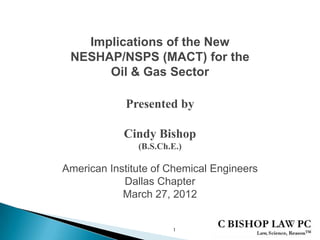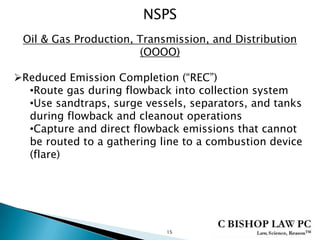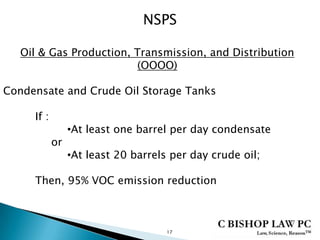Impact of New NSPS and NESHAP Regulations on Oil & Gas Industry
- 1. Implications of the New NESHAP/NSPS (MACT) for the Oil & Gas Sector Presented by Cindy Bishop (B.S.Ch.E.) American Institute of Chemical Engineers Dallas Chapter March 27, 2012 1
- 2. Implications of the New NESHAP/NSPS (MACT) for the Oil & Gas Sector I. What Has Changed? II. Who Is Affected? III. What Needs to Be Done? IV.When Does it Happen? V. What If You DonŌĆÖt Do it? 2
- 3. ORIGIN ’āś Clean Air Act Section 111 ’āś EPA Must List Categories of Stationary Sources That Cause or Contribute Significantly to Air Pollution ’āś EPA Must Issue Performance Standards for Each Category ’āś ŌĆĢBest System of Emission ReductionŌĆ¢ ’āś Cost ’āś Non-air Impacts ’āś Energy Requirements 3
- 4. ORIGIN ’āś NSPS (40 CFR Part 60) ŌĆō New Source Performance Standards ŌĆó New and Modified Sources ŌĆó Industry Specific ŌĆó Focus on Criteria Pollutants (VOCs, SO2) ŌĆó EPA Review Required Every 8 Years 4
- 5. ORIGIN NSPS (continued) ’āś1979 ŌĆō Oil & Gas Production Placed on EPAŌĆÖs Priority List ’āśJune 24, 1985 - NSPS for leaking components at gas processing plants (KKK) ’āśOctober 1, 1985 ŌĆō SO2 regulations from natural gas processing (LLL) 5
- 6. ORIGIN ’āś Clean Air Act Section 112 ’āś NESHAP (40 CFR Part 63) ŌĆō National Emission Standards for Hazardous Air Pollutants ŌĆó New and Existing Sources ŌĆó Industry Specific ŌĆó Major Sources ’āś MACT ŌĆō Maximum Achievable Control Technology ’āś Top 12% ’āś No Cost Consideration ’āś EPA Review Required Every 8 Years 6
- 7. ORIGIN NESHAP (continued) ’āśJuly 16, 1992 ŌĆō EPA Published List of Major and Area Source Categories, including Oil & Gas Production ’āśFebruary 12, 1998 ŌĆō Natural Gas Transmission and Storage Added to List ’āśJune 17, 1999 ŌĆō MACT Issued (HH & HHH) ’āśJanuary 3, 2007 ŌĆō Area Sources 7
- 8. WHY NOW? ’āś January 14, 2009 suit filed ’āś February 4, 2010 ŌĆō Settlement: ŌĆó Proposed Standards by July 28, 2011 ŌĆó Final Action by February 28, 2012 8
- 9. 9
- 10. Who Is Affected? Operations from Well to Refinery or to Customer ŌĆóOnshore & Offshore ŌĆóProduction (well completion and workover) ŌĆóPortable Equipment ŌĆóStorage ŌĆóTransmission 10
- 11. When Does it Happen? ŌĆó Aug. 23, 2011 Rule Proposed Published ŌĆó Oct. 24, 2011 Comment Deadline ŌĆó April 3, 2012 Final Rule ŌĆó ??? 11
- 12. What Has Changed? NSPS ’āś Revised: ŌĆó Equipment Leaks (KKK) ŌĆó SO2 (LLL) ’āś New (OOOO): ŌĆó Hydraulic Fracturing ŌĆó Gas-driven Pneumatic Devices, Centrifugal and Reciprocating Compressors ŌĆó Storage Vessels ’āś Applies to new facilities that were constructed or modified after August 23, 2011 12
- 13. What Has Changed? NESHAP ’āś Revised ŌĆó Oil & Gas Production Facilities (HH) ŌĆó Gas Transmission and Storage (HHH) ’āś New ŌĆó Small Glycol Dehydrators ŌĆó Storage Vessels at Major Sources ’āś Must Notify EPA within 1 year after rule becomes final 13
- 14. NSPS Oil & Gas Production, Transmission, and Distribution (OOOO) Applies to all construction, modification or reconstruction after August 23, 2011 Includes fracking or refracking existing wellhead Compliance date: date of final rule publication. 14
- 15. NSPS Oil & Gas Production, Transmission, and Distribution (OOOO) ’āśReduced Emission Completion (ŌĆĢRECŌĆ¢) ŌĆóRoute gas during flowback into collection system ŌĆóUse sandtraps, surge vessels, separators, and tanks during flowback and cleanout operations ŌĆóCapture and direct flowback emissions that cannot be routed to a gathering line to a combustion device (flare) 15
- 16. NSPS Oil & Gas Production, Transmission, and Distribution (OOOO) ’āśCompressor standards ŌĆóRotating compressor: dry seal system ŌĆóReciprocating compressor: replace rod packing before 26,000 operating hours ’āśPneumatic controller: zero emissions of natural gas if at gas processing plant, otherwise no more than 6 scfh (switch to compressed air driven from gas controller) 16
- 17. NSPS Oil & Gas Production, Transmission, and Distribution (OOOO) Condensate and Crude Oil Storage Tanks If : ŌĆóAt least one barrel per day condensate or ŌĆóAt least 20 barrels per day crude oil; Then, 95% VOC emission reduction 17
- 18. NSPS Sulfur Recovery Units at Onshore Gas Processing Plants SO2 standards: ŌĆó Feed rates of 5 tons per day or greater or ŌĆó With an acid gas stream H2S concentration of 50% or greater ŌĆóSO2 emission reduction of 99.9% (was 99.8%) 18
- 19. NSPS LDAR (Subpart VVa instead of VV) Applies to onshore gas processing plants ŌĆóLower ŌĆĢleakŌĆ¢ threshold ŌĆóMonitoring connectors 19
- 20. NSPS Startup, Shutdown, Malfunction ŌĆóNo ŌĆĢFree PassŌĆ¢ During Startup and Shutdown ŌĆóAffirmative Defense for Malfunctions ŌĆóSudden ŌĆóInfrequent ŌĆóNot reasonably preventable ŌĆóNot caused by poor maintenance or careless operation 20
- 21. NSPS Registration/recordkeeping ŌĆóConstruction, startup, and modification notifications ŌĆóWell registration and 30-day notification prior to each well completion ŌĆóAnnual Compliance Certification ŌĆóThird Party verification ŌĆóElectronic reporting ŌĆóOver 20,000 completions and recompletions annually 21
- 22. NESHAP 22
- 23. 23
- 24. 24
- 25. NESHAP Subparts HH & HHH Addition of Small Glycol Dehydrators ŌĆóOil & Gas Production: gas flowrate < 85,000 scmd or 0.90 Mg/yr benzene emissions ŌĆóExisting sources: 1.10 x 10-4 g BTEX/scm ŌĆóNew sources: 4.66 x 10-6 g BTEX/scm ŌĆóGas Transmission & Storage: gas flowrate < 283,000 scmd or 0.90 Mg/yr benzene emissions ŌĆóExisting sources: 6.42 x 10-5 g BTEX/scm ŌĆóNew sources: 1.10x 10-5 g BTEX/scm ŌĆóTypes of control: process vent ┬╗ control device or closed- vent system 25
- 26. NESHAP Subparts HH & HHH Storage Vessels 95% reduction of HAPs for all storage vessels ŌĆóProcess modifications ŌĆóFlare ŌĆóIncinerator ŌĆóCarbon Filter ŌĆóCondenser Performance Testing of Control Device Elimination of Startup, Shutdown & Malfunction Exemption (See NSPS) 26
- 27. NESHAP Subparts HH & HHH Compliance dates: Existing sources: 3 years after the date of final rule publication New sources (commenced construction on or after August 23, 2011): immediately upon startup or the date of final rule publication, whichever is later 27
- 28. What has industry said? Rules will slow drilling, cut natural gas production and reduce royalties (API) Equipment for capturing emissions during completions is unlikely to be as readily available as EPA assumed, and equipment would have to spend more time at each site than estimated. 28
- 29. What If You DonŌĆÖt Do it? ŌĆó EPA can make you do it ŌĆó Civil Penalties up to $25,000/day/violation ŌĆó Criminal Penalties $250,000 per day per violation and up to five years in jail. Corporations are subject to up to $500,000 per day per violation. ŌĆó $10,000 bounty 29
- 30. EPA Region 6 2011ŌĆö2013 National Enforcement Initiatives 1. Keeping raw sewage and contaminated stormwater out of our nationŌĆÖs waters 2. Preventing animal waste from contaminating surface and ground waters 3. Cutting Toxic Air Pollution that Affects CommunitiesŌĆÖ Health 4. Reducing Widespread Air Pollution from the Largest Sources, especially the Coal-Fired Utility, Cement, Glass, and Acid Sectors 5. Reducing pollution from mineral processing operations 6. ASSURING ENERGY EXTRACTION SECTOR COMPLIANCE WITH ENVIRONMENTAL LAWS ŌĆĢTo address these emerging problems, EPA will develop an initiative to assure that energy extraction activities are complying with federal requirementsŌĆ¢ 30
- 31. ’āś Stay on top of the rules ŌĆōbe organized! ’āś Look for exemptions ’āś Start reviewing operations now ŌĆō do not wait until the rules are final. ’āś Look for innovative/emerging technology ’āś EPA favors those who voluntarily disclose problems. 31
- 32. Implications of the New NESHAP/NSPS (MACT) for the Oil & Gas Sector Presented by Cindy Bishop 214-893-5646 cbishop@cbishoplaw.com www.cbishoplaw.com 32































